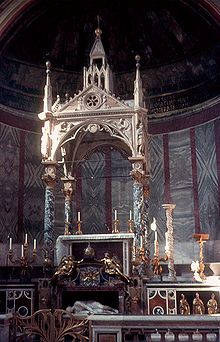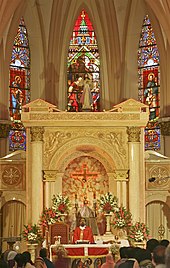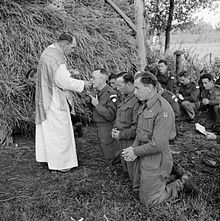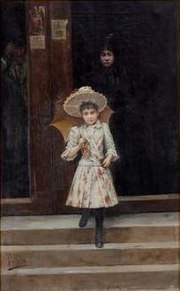Roman Rite
|
A. Introductory rites |
|---|
|
|
B. Liturgy of the Word |
|
|
C. Liturgy of the Eucharist |
|
| D. Concluding rites |
| Ite, missa est |
|
Catholicism portal |

The Roman Rite (
The Roman Rite developed in the
The Roman Rite has been adapted through the centuries and the history of its
Comparison with Eastern rites
The Roman Rite is noted for its sobriety of expression.
Antiquity of the Roman Mass
In his 1912 book on the Roman Mass,
In the same book, Fortescue acknowledged that the Roman Rite underwent profound changes in the course of its development. His ideas are summarized in the article on the "Liturgy of the Mass" that he wrote for the Catholic Encyclopedia (published between 1907 and 1914) in which he pointed out that the earliest form of the Roman Mass, as witnessed in Justin Martyr's 2nd-century account, is of Eastern type, while the Leonine and Gelasian Sacramentaries, of about the 6th century, "show us what is practically our present Roman Mass". In the interval, there was what Fortescue called "a radical change". He quoted the theory of A. Baumstark that the Hanc Igitur, Quam oblationem, Supra quæ and Supplices, and the list of saints in the Nobis quoque were added to the Roman Canon of the Mass under "a mixed influence of Antioch and Alexandria", and that "St. Leo I began to make these changes; Gregory I finished the process and finally recast the Canon in the form it still has."[5]
Fortescue concluded:
- We have then as the conclusion of this paragraph that at Rome the Eucharistic prayer was fundamentally changed and recast at some uncertain period between the fourth and the sixth and seventh centuries. During the same time the prayers of the faithful before the Offertory disappeared, the kiss of peace was transferred to after the Consecration, and the Epiklesis was omitted or mutilated into our "Supplices" prayer. Of the various theories suggested to account for this it seems reasonable to say with Rauschen: "Although the question is by no means decided, nevertheless there is so much in favour of Drews's theory that for the present it must be considered the right one. We must then admit that between the years 400 and 500 a great transformation was made in the Roman Canon" (Euch. u. Busssakr., 86).
In the same article Fortescue went on to speak of the many alterations that the Roman Rite of Mass underwent from the 7th century on (see Pre-Tridentine Mass), in particular through the infusion of Gallican elements, noticeable chiefly in the variations for the course of the year. This infusion Fortescue called the "last change since Gregory the Great" (who died in 604).
The
Liturgy and traditions
Roman Missal

The Roman Missal (
Before the high
Arrangement of churches
The Roman Rite of Mass no longer has the pulpitum, or rood screen, a dividing wall characteristic of certain medieval cathedrals in northern Europe, or the iconostasis or curtain that heavily influences the ritual of some other rites. In large churches of the Middle Ages and early Renaissance the area near the main altar, reserved for the clergy, was separated from the nave (the area for the laity) by means of a rood screen extending from the floor to the beam that supported the great cross (the rood) of the church and sometimes topped by a loft or singing gallery. However, by about 1800 the Roman Rite had quite abandoned rood screens, although some fine examples survive.
Chant
Roman Rite of Mass
The
Although similar in outward appearance to the
Within the fixed structure outlined below, which is specific to the Roman Rite, the Scripture readings, the antiphons sung or recited during the entrance procession or at Communion, and certain other prayers vary each day according to the liturgical calendar.[12]
Introductory rites

The
Liturgy of the Word
On Sundays and solemnities, three Scripture readings are given. On other days there are only two. If there are three readings, the first is from the
Liturgy of the Eucharist

The Liturgy of the Eucharist begins with the preparation of the altar and gifts,[21] while the collection may be taken. This concludes with the priest saying: "Pray, brethren, that my sacrifice and yours may be acceptable to God, the almighty Father." The congregation stands and responds: "May the Lord accept the sacrifice at your hands, for the praise and glory of His name, for our good, and the good of all His holy Church." The priest then pronounces the variable prayer over the gifts.
Then in dialogue with the faithful the priest brings to mind the meaning of "eucharist", to give thanks to God. A variable prayer of thanksgiving follows, concluding with the acclamation "
Communion rite

All together recite or sing the "

The priest then displays the consecrated elements to the congregation, saying: "Behold the Lamb of God, behold him who takes away the sins of the world. Blessed are those called to the supper of the Lamb," to which all respond: "Lord, I am not worthy that you should enter under my roof, but only say the word and my soul shall be healed." Then Communion is given, often with lay ministers assisting with the consecrated wine.[26] According to Catholic teaching, one should be in the state of grace, without mortal sin, to receive Communion.[27] Singing by all the faithful during the Communion procession is encouraged "to express the communicants' union in spirit"[28] from the bread that makes them one. A silent time for reflection follows, and then the variable concluding prayer of the Mass.
Concluding rite
The priest imparts a blessing over those present. The deacon or, in his absence, the priest himself then dismisses the people, choosing a formula by which the people are "sent forth" to spread the good news. The congregation responds: "Thanks be to God." A recessional hymn is sung by all, as the ministers process to the rear of the church.[29]
See also
- List of Catholic rites and churches
- Liturgical books of the Roman rite
- Ordines Romani
References
- ISBN 9781139560306.
- .
- ^ "Bishop succinctly characterizes the 'genius of the Roman rite' as being 'marked by simplicity, practicality, a great sobriety and self-control, gravity and dignity'" (James Norman, Handbook to the Christian Liturgy – Regional Rites V).
- ^ Fr. Adrian Fortescue, The Mass: A Study of the Roman Liturgy, s.l., 1912, p. 213
- ^ New Advent website.
- ^ "Catechism of the Catholic Church – IntraText". www.vatican.va. Retrieved 2020-06-22.
- ISBN 9781438106397.
Anglicans worship with a service that may be called either Holy Eucharist or the Mass. Like the Lutheran Eucharist, it is very similar to the Catholic Mass.
- ISBN 9780195348309.
There is evidence that the late sixteenth-century Catholic mass as held in Germany was quite similar in outward appearance to the Lutheran mass
- ISBN 9780809143658.
Thus Anglican Eucharist is not the same as Catholic Mass or the Divine Liturgy celebrated by Eastern Catholics or Eastern Orthodox. Therefore Catholics may not receive at an Anglican Eucharist.
- ^ a b "Unitatis Redintegratio (Decree on Ecumenism), Section 22". Vatican. Retrieved 8 March 2013.
Though the ecclesial Communities which are separated from us lack the fullness of unity with us flowing from Baptism, and though we believe they have not retained the proper reality of the eucharistic mystery in its fullness, especially because of the absence of the sacrament of Orders, nevertheless when they commemorate His death and resurrection in the Lord's Supper, they profess that it signifies life in communion with Christ and look forward to His coming in glory. Therefore the teaching concerning the Lord's Supper, the other sacraments, worship, the ministry of the Church, must be the subject of the dialogue.
- ISBN 9780814651872.
- ^ Order of the Mass.
- ISBN 9780814657881.
- ISBN 9780814660218.
- ISBN 978-0225665321.
- ISBN 9780814657881.
- ^ GIRM, paragraph 66
- ^ "Homily". The Catholic Encyclopedia (1910).
- ^ GIRM, paragraph 68
- ^ GIRM, paragraph 69
- ^ GIRM, paragraph 73
- ^ Luke 22:19; 1 Corinthians 11:24–25
- ^ GIRM, paragraph 151
- ^ GIRM, paragraph 79c
- ^ Jungmann, SJ, Josef (1948). Mass of the Roman Rite (PDF). pp. 101–259.
- ^ GIRM, paragraph 160
- ^ Compendium of the Catechism of the Catholic Church # 291. Retrieved 20 August 2019.
- ^ GIRM, paragraph 86
- ^ Catholic Sacramentary (PDF). ICEL. 2010.
Further reading
- Baldovin, SJ., John F. (2008). Reforming the Liturgy: A Response to the Critics. The Liturgical Press.
- Bugnini, Annibale (1990). The Reform of the Liturgy 1948–1975. The Liturgical Press.
- Davies, Michael A Short History of the Roman Mass, said to be based on Adrian Fortescue's The Mass: A Study of the Roman Liturgy
- Foley, Edward; Mitchell, Nathan D.; and Pierce, Joanne M. A Commentary on the General Instruction of the Roman Missal. The Liturgical Press.
- Johnson, Lawrence, J. (2009). Worship in the Early Church: An Anthology of Historical Sources. The Liturgical Press.
- Marini, Piero (Archbishop) (2007). A Challenging Reform: Realizing the Vision of the Liturgical Renewal. The Liturgical Press.
- Metzger, Marcel (1997). History of the Liturgy: The Major Stages. Translated by Beaumont, Madeleine M. The Liturgical Press. ISBN 9780814624333.
- Morrill, Bruce T., SJ, contributing editor. Bodies of Worship: Explorations in Theory and Practice. The Liturgical Press.
External links
- Liturgy of the Mass (Catholic Encyclopedia)
- The Roman Rite (Catholic Encyclopedia)
- Australian site, mainly on present form of the Roman Rite
